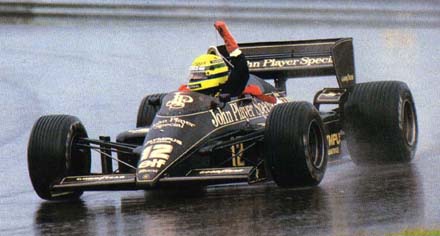Hi Guys,
Formula one cars of the 70's/80's used turbos. Does anyone know what rpm these turbochargers spun at?
Thanks.
- Login or Register
No account yet? Sign up
Welcome to forum. Around 150.000 rpm if I'm not mistaken.brock 108 wrote:Hi Guys,
Formula one cars of the 70's/80's used turbos. Does anyone know what rpm these turbochargers spun at?
Thanks.
A little F1 Turbo history…….
In 1986,when the rules allowed turbocharged engines, the money teams were building special “Kamikaze” engines just for qualifying. they could spin their wheel on a dry track in any gear ,including 6 gear.BMW calculated that there were moments when they were getting 1300 HP from there 1.5-litre engine. When Gerhard Berger saw a 5.5 bar boost on his turbo pressure gauge at Monza during qualifying in 1986,it meant he was getting five and a half times atmospheric pressure of fuel and air into his combustion chamber. So theoretically his little 1.5-litre engine was pumping out power like an 8.25-litre monster.1300 horse power from 1.5 litres made those engine’s go boom in the afternoon session’s of qualifying. They only lasted 20 laps……..
Crazy stuff....dont you think....
Both turbine and compressor speed (blade tip speed) is important if you want to reach high boost pressures. Based upon the Euler turbomachine equation and some assumptions about the turbine and compressor one can calculate the blade tip speed required for a certain compressor pressure ratio. To reach pressure ratios around 6 (needed for a boost of around 5.5 bar absolute) you typically need a turbine blade tip speed of around 500 m/s. With a 63 mm turbine that equals to around 150,000 rpm.
The compressor blade tip speed used was slightly higher (the compressor wheel is also larger), around 640 m/s. For an 82 mm compressor that equals to around 150,000 rpm (the IHI RX6D turbocharger used on the Hondas had a 62.9 mm turbine and a 82 mm compressor and used speeds up to 160,000 rpm). Since the centrifugal stress is proportional to the square of the blade tip speed, this should indicate that the stress was around 60% higher in F1 than in normal turbocharger applications and the compressor wheels where therefore billet machined from a forged piece of high strength aluminium (7075 was used, at least initially).
Since the inducer tip speed is supersonic at some conditions the F1 turbochargers where equipped with a trans-sonic inducer design.



I wouldn't say that. They're practically exclusive to each other but it's much easier to measure boost, so everyone does that.manchild wrote:Well, now you know.It's not about rpm as much as it is about pressure.

and there's this... electromagnetic bearing with no friction at all - axle levitates within magnetic field.Ciro Pabón wrote:I've read of gas bearings that allow you to reach over 800.000 rpm: http://www.iop.org/EJ/abstract/0960-1317/15/9/S08 That's not an article but an abstract. However, I swear I read about them a few years ago, now I cannot find the article.

